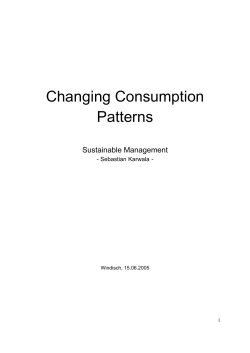
Assessment of animal welfare in zoos
Assessment of animal welfare in zoos Dr Heather J. Bacon BSc BVSc CertZooMed MRCVS Jeanne Marchig International Centre for Animal Welfare Education University of Edinburgh The role of the modern zoo EDUCATION CONSERVATION WELFARE RESEARCH Why is good welfare so important? • Conservation – Populations must be fit for breeding and reintroduction purposes, poor welfare can lead to stress, suppression of immune function and a decrease in reproductive fitness Why is good welfare so important? • Education – Animals should exhibit natural behaviours to educate the public about their natural habits Why is good welfare so important? • Research – Healthy animals exhibiting natural behaviours can give us valuable information on how their wild counterparts live and behave How do we measure welfare? • Subjective Vs Objective measurements – E.g. Assessment of an animal looking ‘stressed’ Vs faecal cortisol screening demonstrating measurable stress hormone changes • Qualitative Vs Quantitative – E.g. An opinion on how much time an animal spends performing stereotypic behaviour Vs an activity budget ethogram recording measurable behaviours • Objective quantitative measures preferred as more reliable and can measure the impact of any further changes we then implement. Snapshot Welfare Assessments • Of limited use – 1 moment in time • No information on husbandry, keeper interaction, management programmes, training, enrichment, previous history, medical needs etc • Enclosure assessment and group demographics may be possible Five Freedoms • 1. Freedom from Hunger and Thirst - by ready access to fresh water and a diet to maintain full health and vigour. • 2. Freedom from Discomfort - by providing an appropriate environment including shelter and a comfortable resting area. • 3. Freedom from Pain, Injury or Disease - by prevention or rapid diagnosis and treatment. • 4. Freedom to Express Normal Behaviour - by providing sufficient space, proper facilities and company of the animal's own kind. • 5. Freedom from Fear and Distress - by ensuring conditions and treatment which avoid mental suffering. Five Freedoms • A subjective and qualitative measure • Brambell Comission (UK govt) 1965, welfare of intensively farmed animals • Do not encourage positive welfare – at best a ‘neutral welfare state’ can be achieved • Now – ‘Life worth living’ – ‘Good life’ • Modern ethologists place emphasis on minimising negative welfare aspects plus increasing opportunities for positive welfare Telos • Telos is the innate nature of an animal – the pig-ness of a pig or the chimp-ness of a chimpanzee • Explains the strong neurobiological drive to fulfil certain behavioural activities even if all physical needs are met Defining behaviour Natural behaviour has been defined as a behaviour that is “ typically observed in the wild; it is adaptive in the evolutionary sense…(i.e.) has evolved by natural selection which allows an individual to survive more easily in its particular environment and so gives it a better chance of leaving offspring than an animal not so adapted” (Poole, 1988b, p. 3). Unnatural behaviour is defined as a behaviour that is “not seen in the wild. Not all unnatural behaviours are regarded as abnormal, however, as they may promote success within the captive environment” (Poole, 1988b, p. 3-4). Defining Behaviour Normal behaviour will “promote the success and survival of the individual and its genetic contribution to the population” and is “clearly appropriate to the particular situation”. It may also “be either natural or unnatural” (Poole, 1988b, p. 4). Abnormal behaviour is defined as a behaviour that is “rarely seen in wild populations and does not promote the success and the survival of the individual or its close relatives (i.e. it does not increase fitness). It appears not to be goal oriented, so that its function is not apparent.” It “may include elements of normal activities, but they are performed in an inappropriate fashion” (Poole, 1988b, p. 4). Behaviour Abnormal behaviour is of the most concern • Examples of abnormal behaviour include: – Stereotypy (repetitive, aimless behaviour) – Overgrooming/feather plucking – Self-mutilation How do we assess behaviour in relation to welfare? • By analysing how an animal behaves, we can compare its behaviour to other animals of the same species. • We can assess whether it’s behaviour is normal and functional • We can identify any abnormal behaviours and quantify them as a % of the animal’s ‘activity budget’ Ethograms and Activity Budgets • Ethogram – Tool for measuring a specific behaviour or a number of behaviours in an individual • Activity Budget – The proportion of time an animal spends exhibiting each recorded behaviour Ethogram BEHAVIOUR OBSERVATION SHEET Bear Name/No: __________________ Location: ____________ Date: __________ Time: from ____to____ Observer: _______________ Weather Conditions: Season: ______________ Average/Approximate Temperature (Celcius) :_______________ Comments: ________________________________ Fine □ Cloudy/Overcast □ Wet □ Windy □ Stormy □ Hot □ Humid □ Warm □ Cool □ Cold □ OBSERVATIONS: When observing bear/s, record behaviours from the list below. Record behaviours every _____________. Total Time Observed: _______mins Feeding Play Rest Forage ________________________ Play – enrichment __________________________ Rest alone ___________________ Feed in Den ________________________ Play – enclosure fixtures __________________________ Rest with other/s_______________ Explore/Investigate Interactions If known: Environment _______________________ Play ______________________________________→ With who _____________________ Enrichment _________________________ Aggression: Vocalise_____________ Fight____________ → Other bear/s __________________ Bears _________________________ Avoidance (moves away) ___________________________→ From who _____________________ Other _________________________ Other ______________________________________→ Other bear/s___________________ Stereotypic Compulsive General Behaviour Pacing _______________________________ Excessive salivating/foaming ________________________ Alert □ Observ. of surrounds □ Weave in front of dens__________________ Self Directed Behaviour: Responsive to keepers □ Head sway____________________________ - Self sucking or biting ______________________________ Lethargic □ Not observant □ Bar biting _____________________________ - Slapping/hitting __________________________________ Non-responsive to keepers □ Food regurgitation _____________________ - Excessive grooming ________________________________ Other _________________________________ - Other _____________________________________________ General Health Noise Present Yes □ No □ Duration ____ Noise Type ______________________________ Normal □ Abnormal □ Unsure □ People Present Yes □ No □ Duration ____ Who/How many ___________________________ Poss. Injury □ ____________ Out of Sight _____________________________________________________________ Faeces – Normal □ Abnormal □ General Comments: Add specific comments overleaf. Vomiting □ Vet/BM to view □ Percentages: Feed_____ Play _____ Rest _____ Explore _____ Interactions_____ Stereotypic____ Compulsive______ Out of Sight______ Activity budgets • Once behaviours are recorded, we can compare against individuals of the same species within the zoo, at other zoos or even in the wild Activity Budgets • Analysis of activity budgets can highlight – Reduced behavioural repertoires – Abnormal behaviours such as stereotypy – A behaviour being performed excessively – The effect of human interventions e.g medical treatment, visitor effects or enrichment Cortisol analysis • Cortisol is a steroid hormone, produced by the adrenal gland in response to stress • Actions – Increases blood glucose – Suppresses the immune system (decreased lymphocyte proliferation) – Decreases bone formation – Promotes metabolism of fat and carbohydrate – Inhibits reproduction (suppresses pulsatile LH secretion) Cortisol LUTINISING HORMONE FOLLICLE STIMULATING HORMONE LH and FSH surge is essential for ovulation, and is inhibited by cortisol Cortisol • Can be measured in serum, urine, saliva, faeces and hair. Cortisol • Faecal cortisol levels in spider monkeys in different habitats. • Lowest cortisol levels are in wild monkeys in conserved habitat. Highest levels are in pet monkeys BZ A NEX B Cortisol • A = Differences in salivary cortisol in jaguars at two different zoos (NEX and BZ) • B = Salivary cortisol levels in jaguars at the same two zoos on days where visitors are present (black) and are not present (grey) • Difference is in location of public viewing area in relation to enclosure Disease Prevalence • In general captive animals live longer than their wild counterparts • But is quantity of life a good welfare indicator? • We need to look at quality of life also • Disease is detrimental to welfare, and it may be exacerbated by stress • Captive animals may suffer from disease syndromes not recorded in the wild Disease Prevalence • Infectious disease – Human TB (Mycobacterium tuberculosis), Salmonella, E.coli etc – Canine distemper virus, infectious hepatitis, Feline herpesvirus, Elephant endotheliotropic herpesvirus • Husbandry-related disease – Foot problems in elephants Disease Prevalence • Nutritional disease – Nutritional hyperparathyroidism in large cats – Hsing-Hsing, the panda at the National zoo in Washington fed snacks of blueberry muffin – Cholesterol granulomas in meerkats • Human-induced disease – Female rhino at Granby zoo Quebec died after inhaling plastic Disease Prevalence • Multi-factorial disease – Alopecia in spectacled bears • Genetics, husbandry, allergies? – Mortality in captive Orcas • Immune suppression, dental disease, early parturition – Feather plucking in parrots • Stress, husbandry, nutrition, UV access Other measures • Reproductive success – Asian elephants have poor reproductive records in captivity due to stress, herpesvirus infection, foot and musculoskeletal disease – Many species require high levels of reproductive management e.g. artificial insemination or embryo transfer. As these animals would naturally breed in the wild is this extreme intervention indicative of stress inhibiting reproduction? Summary so far.. • Inadequate captive environments, poor nutrition, inappropriate visitor behaviour and poor keeper training can all create stress for captive animals • Stress induces high cortisol levels, inhibiting reproduction, suppressing the immune system, decreasing normal behaviours and inducing abnormal behaviours • Creating a low stress environment can increase behavioural repertoire and promote animal health and reproduction. How do we create a lowstress environment? • Gather information on natural state and needs - Telos – – – – Natural history and ecology Feeding behaviour Social behaviour Habitat • Assess captive state using ethograms to assess activity budgets • Consider – Enclosure design, diet, keeper interaction, visitor viewing access, husbandry routine, behavioural repertoire, enrichment and enclosure furnishings How do we create a low-stress environment? Assess data collected and implement changes e.g. providing enclosure furniture to encourage more varied behaviour Consider educational signage to change visitor behaviour, plants to screen visitors from view or changing the location of visitor viewing areas. Behavioural Management Strategies • Behavioural management allows the development of proactive standards for the care and psychological well-being of captive animal • Behavioural management incorporates behavioural enrichment, training, animal behaviour issues, and exhibit architecture and husbandry. Enclosure design Enclosure design Behaviour Behaviour Human interaction Human interaction Summary • Welfare assessment in captive wildlife can be difficult but it is possible. • Stress can predispose to a number of physical and mental diseases • Zoos should continually assess and audit their management practices to reduce stress and enhance quality of life • Remember the importance of Telos, behaviour and mental health • Aim to ensure “A Good Life” Thank You Heather.Bacon@ed.ac.uk JM.Welfare@ed.ac.uk
© Copyright 2025










